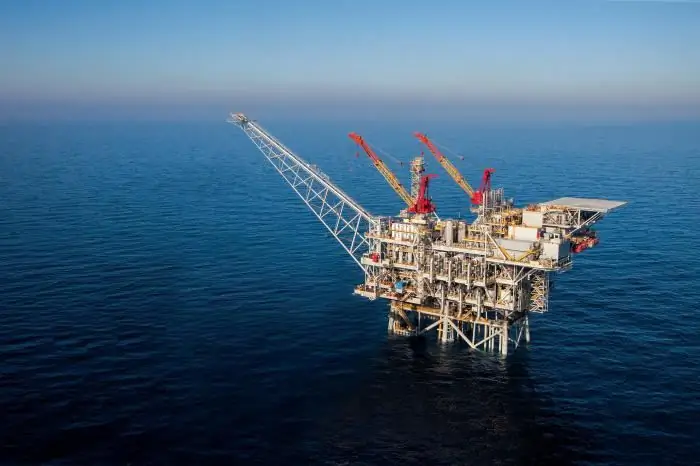2026 Author: Howard Calhoun | [email protected]. Last modified: 2025-01-24 13:10:32
Humanity has always been in search of new energy sources that can solve many problems. However, they are not always safe. So, in particular, the nuclear reactors widely used today, although they are capable of generating simply a colossal amount of such electrical energy that everyone needs, still carry a mortal danger. But, in addition to the use of nuclear energy for peaceful purposes, some countries of our planet have learned to use it in the military, especially to create nuclear warheads. This article will discuss the basis of such a destructive weapon, the name of which is weapons-grade plutonium.
Quick reference
This compact form of the metal contains at least 93.5% of the 239Pu isotope. Weapons-grade plutonium was named so in order to distinguish it from its “reactor brother”. In principle, plutonium is always formed in absolutely any nuclear reactor, which, in turn, runs on low-enriched or natural uranium, which contains, for the most part, the isotope 238U.

Military applications
Weapon-grade plutonium 239Pu is the basis of nuclear weapons. At the same time, the use of isotopes with mass numbers 240 and 242 is irrelevant, since they create verya high background of neutrons, which ultimately makes it difficult to create and design highly effective nuclear ammunition. In addition, plutonium isotopes 240Pu and 241Pu have a much shorter half-life than 239Pu, so plutonium parts get very hot. It is in connection with this that engineers are forced to add additional elements to a nuclear weapon to remove excess heat. By the way, pure 239Pu is warmer than the human body. It is also impossible not to take into account the fact that the decay products of heavy isotopes subject the metal crystal lattice to harmful changes, and this quite naturally changes the configuration of plutonium parts, which, in the end, can cause a complete failure of a nuclear explosive device.
By and large, all of these difficulties can be overcome. And in practice, explosive devices based on "reactor" plutonium have already been repeatedly tested. But it should be understood that in nuclear munitions, their compactness, low own weight, durability and reliability are far from the last position. In this regard, they use exclusively weapons-grade plutonium.

Design features of industrial reactors
Practically all plutonium in Russia was produced in reactors equipped with a graphite moderator. Each of the reactors is built around cylindrical graphite blocks.
When assembled, graphite blocks have special slots between them to ensure continuous circulation of the coolant, whichnitrogen is used. In the assembled structure, there are also vertically arranged channels created for the passage of water cooling and fuel through them. The assembly itself is rigidly supported by a structure with holes under the channels used to ship already irradiated fuel. In addition, each of the channels is located in a thin-walled pipe cast from a lightweight and extra-strong aluminum alloy. Most of the described channels have 70 fuel rods. The cooling water flows directly around the fuel rods, removing excess heat from them.

Increasing the capacity of production reactors
Initially, the first Mayak reactor operated with a capacity of 100 thermal MW. However, the chief head of the Soviet nuclear weapons program, Igor Kurchatov, proposed that the reactor should operate at 170-190 MW in winter and 140-150 MW in summer. This approach allowed the reactor to produce almost 140 grams of precious plutonium per day.
In 1952, full-fledged research work was carried out in order to increase the production capacity of functioning reactors by the following methods:
- By increasing the flow of water used for cooling and flowing through the cores of a nuclear facility.
- By increasing resistance to the phenomenon of corrosion occurring near the channel liner.
- Reducing the rate of graphite oxidation.
- Increasing the temperature inside the fuel cells.
As a result, the throughput of the circulating water has increased significantly after the gap between the fuel and the walls of the channel has been increased. We also managed to get rid of corrosion. To do this, we chose the most suitable aluminum alloys and began to actively add sodium bichromate, which ultimately increased the softness of the cooling water (pH became about 6.0-6.2). Graphite oxidation ceased to be an actual problem after nitrogen was used to cool it (previously only air was used).

As the 1950s drew to a close, innovations were fully put into practice, reducing the highly unnecessary ballooning of uranium caused by radiation, greatly reducing the heat hardening of uranium rods, improving cladding resistance, and improving manufacturing quality control.
Production at Mayak
"Chelyabinsk-65" is one of those very secret factories where weapons-grade plutonium was created. There were several reactors at the enterprise, we will get to know each of them better.
Reactor A
The unit was designed and built under the guidance of the legendary N. A. Dollezhal. She worked with a power of 100 MW. The reactor had 1149 vertically arranged control and fuel channels in a graphite block. The total mass of the structure was about 1050 tons. Almost all channels (except 25) were loaded with uranium, the total mass of which was 120-130 tons. 17 channels were used for control rods and 8 forconducting experiments. The maximum design heat release of the fuel cell was 3.45 kW. At first, the reactor produced about 100 grams of plutonium per day. Plutonium metal was first produced on April 16, 1949.
Technological flaws
Quite serious problems were identified almost immediately, which consisted of corrosion of aluminum liners and fuel cell coatings. The uranium rods also swelled and broke, and cooling water leaked directly into the core of the reactor. After each leak, the reactor had to be shut down for up to 10 hours in order to dry the graphite with air. In January 1949, the channel liners were replaced. After that, the launch of the installation took place on March 26, 1949.
Weapon-grade plutonium, the production of which at Reactor A was accompanied by all sorts of difficulties, was produced in the period 1950-1954 with an average unit power of 180 MW. The subsequent operation of the reactor began to be accompanied by its more intensive use, which quite naturally led to more frequent shutdowns (up to 165 times a month). As a result, in October 1963, the reactor was shut down and resumed its operation only in the spring of 1964. He completed his campaign in 1987 and produced 4.6 tons of plutonium over the entire period of many years of operation.
AB Reactors
It was decided to build three AB reactors at the Chelyabinsk-65 enterprise in the fall of 1948. Their production capacity was 200-250 grams of plutonium per day. The chief designer of the project was A. Savin. Each reactor had 1996 channels, 65 of them were control channels. A technical novelty was used in the installations - each channel was equipped with a special coolant leak detector. Such a move made it possible to change the liners without stopping the operation of the reactor itself.
The first year of operation of the reactors showed that they produced about 260 grams of plutonium per day. However, already from the second year of operation, the capacity was gradually increased, and already in 1963 its figure was 600 MW. After the second overhaul, the liners problem was completely solved, and the capacity was already 1200 MW with an annual plutonium production of 270 kilograms. These indicators remained until the complete closure of the reactors.

AI-IR reactor
The Chelyabinsk enterprise used this installation from December 22, 1951 to May 25, 1987. In addition to uranium, the reactor also produced cob alt-60 and polonium-210. Initially, the site produced tritium, but later began to receive plutonium.
Also, the plant for the processing of weapons-grade plutonium had in operation heavy water reactors and the only light water reactor (its name is Ruslan).

Siberian giant
"Tomsk-7" - this is the name of the plant, which houses five reactors for the production of plutonium. Each of the units used graphite to slow down neutrons and ordinary water to provide proper cooling.
Reactor I-1 worked with the systemcooling, in which the water passed once. However, the remaining four units were provided with closed primary circuits equipped with heat exchangers. This design made it possible to additionally generate steam, which in turn helped in the production of electricity and heating of various residential premises.
"Tomsk-7" also had a reactor called EI-2, which, in turn, had a dual purpose: it produced plutonium and generated 100 MW of electricity from the generated steam, as well as 200 MW of thermal energy.

Important information
According to scientists, the half-life of weapons-grade plutonium is about 24,360 years. Huge number! In this regard, the question becomes especially acute: “How to properly deal with the production waste of this element?” The most optimal option is the construction of special enterprises for the subsequent processing of weapons-grade plutonium. This is explained by the fact that in this case the element can no longer be used for military purposes and will be controlled by a person. This is how weapons-grade plutonium is disposed of in Russia, but the United States of America took a different path, thus violating its international obligations.
Thus, the US government proposes to destroy highly enriched nuclear fuel not in an industrial way, but by diluting plutonium and storing it in special containers at a depth of 500 meters. It goes without saying that in this case the material can easily beextract it from the ground and re-launch it for military purposes. According to Russian President Vladimir Putin, initially the countries agreed to destroy plutonium not by this method, but to carry out recycling at industrial facilities.
The cost of weapons-grade plutonium deserves special attention. According to experts, tens of tons of this element may well cost several billion US dollars. And some experts have even estimated 500 tons of weapons-grade plutonium as much as 8 trillion dollars. The amount is really impressive. To make it clearer how much money this is, let's say that in the last ten years of the 20th century, the average annual GDP of Russia was $400 billion. That is, in fact, the real price of weapons-grade plutonium was equal to twenty annual GDP of the Russian Federation.
Recommended:
Modern production. The structure of modern production. Problems of modern production

Developed industry and a high level of the country's economy are key factors influencing the we alth and well-being of its population. Such a state has great economic opportunities and potential. A significant component of the economy of many countries is the production
Gas production. Gas production methods. Gas production in Russia

Natural gas is formed by mixing various gases in the earth's crust. In most cases, the depth of occurrence ranges from several hundred meters to a couple of kilometers. It is worth noting that gas can form at high temperatures and pressures. In this case, there is no access of oxygen to the place. To date, gas production has been implemented in several ways, each of which we will consider in this article. But let's talk about everything in order
ATGM - a weapon to destroy tanks. ATGM "Kornet": specifications

An anti-tank guided missile (ATGM) is a weapon designed primarily to combat enemy armored vehicles. It can also be used to destroy fortified points, fire at low-flying targets and for other tasks
Thermobaric weapon. vacuum bomb. Modern weapons of Russia

The article is devoted to modern weapons. In particular, the principles of the construction of thermobaric and vacuum bombs, new developments regarding nuclear weapons and other types of high-tech weapons are considered
Materials released to production (posting). Accounting for the disposal of materials. accounting entries

Most of all existing enterprises can not do without inventories used to produce products, provide services or perform work. Since inventories are the most liquid assets of the enterprise, their correct accounting is extremely important

